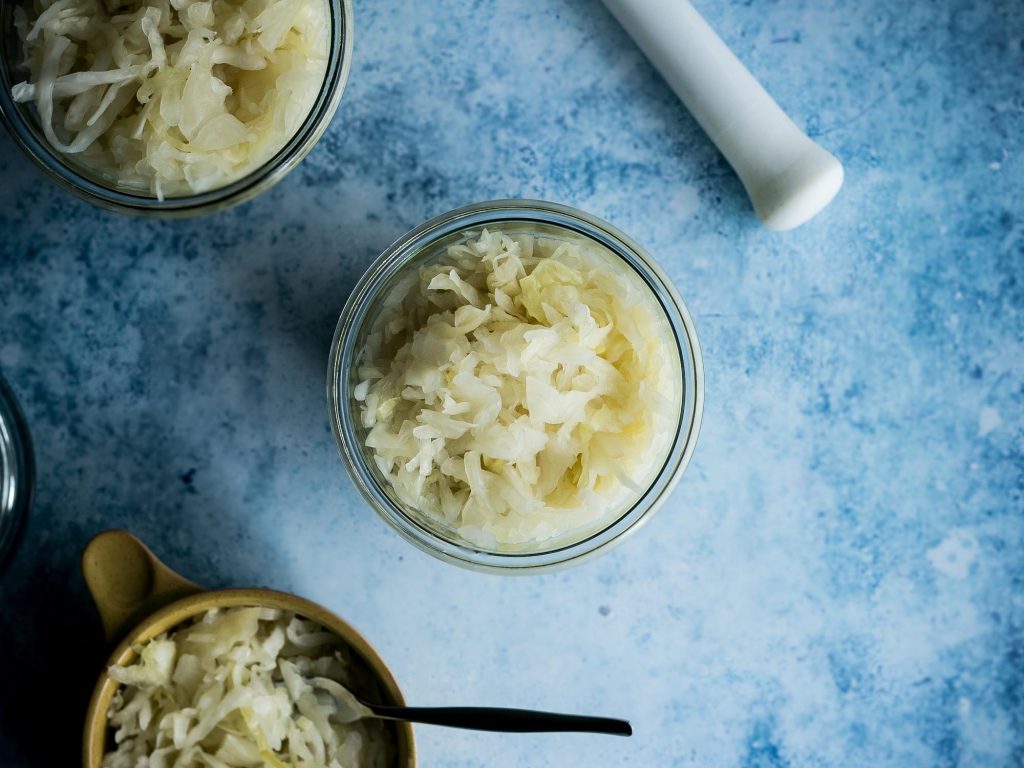Sauerkraut

Sauerkraut
Sauerkraut is really just two ingredients – salt and cabbage and getting the balance of salt right so that the right bacteria can do its thing and you get a fermentation of the cabbage. Since cabbages come in different sizes, it’s easier to work off ratios but I’ve given you an example if you’re working with 1kg of cabbage. You’re aiming for salt levels to be between 1.5-2.5% of the weight of the cabbage. I usually work off a tablespoon of salt but because tablespoons can be different sizes, I measured out what 1 tablespoon of salt was for me.
INGREDIENTS
1kg of shredded green cabbage (I use a mandolin to do this but you can easily finely shred a cabbage with a knife on a chopping board)
17g salt
METHOD
Place the cabbage in a large mixing bowl or plastic tub and sprinkle the salt all over. Mix the salt thoroughly into the cabbage and set aside for 30 minutes. This will help draw out some of the cabbage liquid and save you some effort.
After 30 minutes, get your hands and squeeze the cabbage, some liquid will come out. You can keep squeezing by hand but I find that process very exhausting so I just use a pestle and gently pound down on the cabbage. As you do this, more and more liquid will be released. This can take up to 10 minutes but that’s only a guide. When you press down on the cabbage, you should be able to completely submerge it in the liquid.
Transfer the cabbage into wide mouth jars, packing it in really tightly. I press down regularly as I layer the cabbage in to get rid of any air bubbles. I fill the jar 4/5 full – you need to leave room for a smaller sized jar to fit in. The smaller sized jar should be filled with water and fit neatly into your bigger jar. It acts as a weight, forcing the cabbage to be submerged into the brine you’ve created. REMEMBER – anything above the brine is at risk of becoming mouldy. I find with 1kg of cabbage I can pack it into two 500ml Weck Jars. I then put the jars in a dark corner of my house and cover with cheesecloth to stop anything falling or getting into the sauerkraut. Some people say the jars need to be air tight but as long as everything is submerged into the brine and you’ve completely covered the jars with the cheesecloth, it’ll be fine.
Check on the sauerkraut daily to look for signs of fermentation. You’ll start to see bubbles forming on the side of the jar, that’s a good indication that fermentation is happening. Make sure that the cabbage stays fully submerged. Unless it’s really cold, the fermentation will be done by 10-14 days but you can taste it to see if you like the flavour. The longer you leave it, the softer and tangy it becomes. I prefer a little bite to my sauerkraut. When I’m happy that it’s fermented enough, I remove the small jars and put the lids on the jars of sauerkraut and store them in the fridge. Each time you take some sauerkraut out to eat, make sure you use a clean utensil so you don’t contaminate it.
Tips:
- You don’t need to sterilise the jars but make sure you work clean. Clean hands and clean utensils.
- You can play around and add in some carrot for colour or try different types of cabbage.
- Unopened jars of sauerkraut can be stored in the fridge for a few months.
